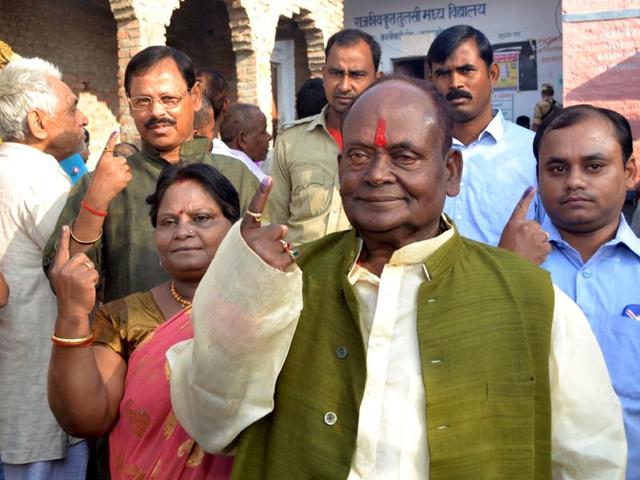Leadership ratings: Is it the biggest clue to Bihar election results?
The Narendra Modi- Amit Shah jodi has thrown their entire weight behind the campaign to ensure a BJP victory. Any loss here could have serious ramifications on the continuation of Shah as the president of the party.
In less than a week from now, the results of the 2015 assembly elections will be known. Whichever side wins, the results would have immediate bearing on politics across the country. The Narendra Modi- Amit Shah jodi has thrown their entire weight behind the campaign to ensure a BJP victory. Any loss here could have serious ramifications on the continuation of Shah as the president of the party.

While most of the opinion polls say the NDA will emerge victorious (in-fact only two, Cicero and CNN IBN put the Grand Alliance on top), all of them consistently show that Kumar is the top choice for the chief minister’s post among voters. The NDA’s unnamed CM candidate comes up with a share which is much lower than the predicted NDA share. This contradiction is unusual and could play a crucial role in determining the outcome.
Nitish Kumar as Bihar chief minister is fairly popular. About 64% voters in the Lok Sabha election said they were satisfied with his government’s performance (CSDS Poll). Infact according to Ipsos, satisfaction levels with the Nitish Kumar government is higher than satisfaction levels with the Narendra Modi government. Still, a poll of polls (of 3 polls used below) shows that the NDA is expected to garner 0.6% higher vote share than the Grand Alliance.
We considered a small sample of recent elections (for which full data was available) and noticed an interesting trend. In all the cases, the gap between leadership ratings and vote share/ intention to vote ratings was quite small. In fact in the National Election study by CSDS during the Lok Sabha election, the preference for Modi was 35.7%, and the NDA vote share was 38.5%. In 2009, the combined rating of UPA leaders was 39.7% against a vote share of 36.5%.

The data for Bihar show a huge gap for the Grand Alliance where Nitish scores an average of 48% versus an average intention to vote of 40.7% . Similarly, in the case of the NDA, the sum of the top three candidates is significantly lower than the predicted vote share. This sort of contradiction did not exist in Maharashtra where the sum of the leading BJP candidates was almost equal to the final vote share.
There could be different explanations for the divergence
* Unlike other elections, including Maharashtra, Kumar is a popular incumbent and is therefore likely to get higher ratings due to the absence of a known opponent.
* While Kumar is popular, the voting intention is perhaps affected by the poor ratings for his alliance partners, the RJD and Congress.
* The caste polarisation means that many of the voters may be making choices not just on the basis of leadership, but on caste affiliations
While the above explanations are logical, it is unclear how this will play out in a close election in Bihar.
A similar trend was visible in the Delhi polls held earlier this year. Initially, all polls gave a higher vote share to the BJP while Kejriwal remained the most preferred CM candidate. This contradiction was eventually corrected by the mid of January when polls gave Aam Aadmi Party (AAP) the lead in terms of vote share as well, though popularity of Kejriwal dipped a bit due to announcement of Kiran Bedi as BJP CM candidate. The vote share gap moved in tandem with the popularity gap between Kejriwal and the second top contender and turned from negative to Advantage AAP just ahead of polling.

In Bihar, Nitish Kumar has continued to top the charts, even in polls which predict a win and a higher vote share for the NDA. Sushil Modi did manage to close the gap by the first phase of polls, but this anomaly of sorts could not be corrected across most of the opinion polls, except in those by Cicero and CNN-IBN.
So what does this mean for the Bihar elections?
Intuitively, this favours the Grand Alliance like it did in Delhi. For example, Yadav (19% voted for NDA in LS polls) and Kurmi (30% voted for NDA in LS polls) voters, who chose the NDA in the Lok Sabha election, may have a higher incentive to return to their caste fold given the high ratings for Nitish Kumar. EBC voters (53% voted for NDA in LS polls) are also likely to be more open to vote for the better leadership, given that this segment is not well represented in both the alliances. Leadership was one of the key factors which differentiated the BJP from other parties in the LS polls, and catapulted it to an an absolute majority.
These theories will be put to test in each constituency where myriad other factors like anti-incumbency against sitting MLA, rebel candidates, caste combinations and turnout would also drive voter choice. Whether this could play out like in the past, or a new chapter would be written, will be known on the 8th of November. Either way, there will be a new learning from the 2015 Bihar elections.
(Suryakiran Tiwari is an independent political commentator)



